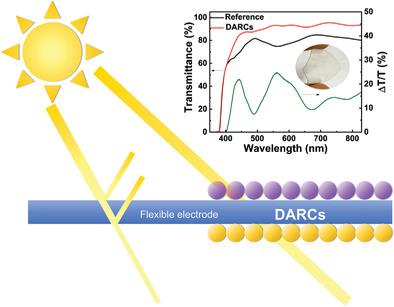Our official English website, www.x-mol.net, welcomes your
feedback! (Note: you will need to create a separate account there.)
Near 90% Transparent ITO-Based Flexible Electrode with Double-Sided Antireflection Layers for Highly Efficient Flexible Optoelectronic Devices
Small ( IF 13.0 ) Pub Date : 2022-04-14 , DOI: 10.1002/smll.202201716 Jinxia Zhang 1, 2 , Xiaoxuan Li 3 , Meiyan Zhong 1 , Zhenzhen Zhang 1 , Mingdi Jia 3 , Jin Li 1 , Xiaowen Gao 1 , Langxing Chen 3 , Qi Li 1 , Wenhua Zhang 2 , Dongsheng Xu 1
Small ( IF 13.0 ) Pub Date : 2022-04-14 , DOI: 10.1002/smll.202201716 Jinxia Zhang 1, 2 , Xiaoxuan Li 3 , Meiyan Zhong 1 , Zhenzhen Zhang 1 , Mingdi Jia 3 , Jin Li 1 , Xiaowen Gao 1 , Langxing Chen 3 , Qi Li 1 , Wenhua Zhang 2 , Dongsheng Xu 1
Affiliation

|
As a widely used substrate for flexible electronics, indium-tin oxide-based polymer electrodes (polymer-ITO electrodes) exhibit poorly visible light transmittance of less than 80%. The inferior transmittance for polymer-ITO electrodes severely limits the performance improvement of polymer-ITO based electronics. Here, a conceptually different approach of the double-sided antireflection coatings (DARCs) strategy is proposed to modulate both the air–polymer substrate interface and ITO–air interface refractive index gradient, to synergistically improve the transmittance of polymer-ITO electrodes. On the basis of SiO2 nanoparticles antireflection layer on polymer substrate, a polymer–metal oxide composite antireflection film is fabricated on the ITO side. Resultantly, the transmittance of ITO-based flexible electrodes is successfully improved from 76.8% to 89.8%, which is the highest transmittance among the reported ITO-based flexible electrodes. Furthermore, the photoluminescence emission intensity of luminescent materials enveloped with the DARCs electrodes increases by 74% over that with reference electrodes, demonstrating the DARCs antireflection strategy can efficiently improve the performance of flexible optoelectronic devices. With DARCs electrode, the flexible perovskite solar cells exhibit an enhanced efficiency from 18.80% to 20.85%.
中文翻译:

用于高效柔性光电器件的具有双面减反射层的近 90% 透明 ITO 基柔性电极
作为柔性电子产品广泛使用的基板,基于氧化铟锡的聚合物电极(聚合物-ITO电极)的可见光透射率较差,低于80%。聚合物-ITO 电极较差的透射率严重限制了基于聚合物-ITO 的电子器件的性能改进。在这里,提出了一种概念上不同的双面减反射涂层 (DARC) 策略方法来调节空气-聚合物基板界面和 ITO-空气界面折射率梯度,以协同提高聚合物-ITO 电极的透射率。基于SiO 2纳米粒子减反射层在聚合物衬底上,在ITO侧制作聚合物-金属氧化物复合减反射膜。结果,ITO 基柔性电极的透光率成功地从 76.8% 提高到 89.8%,这是已报道的 ITO 基柔性电极中透光率最高的。此外,用 DARCs 电极包裹的发光材料的光致发光强度比参考电极增加了 74%,表明 DARCs 抗反射策略可以有效地提高柔性光电器件的性能。使用 DARCs 电极,柔性钙钛矿太阳能电池的效率从 18.80% 提高到 20.85%。
更新日期:2022-04-14
中文翻译:

用于高效柔性光电器件的具有双面减反射层的近 90% 透明 ITO 基柔性电极
作为柔性电子产品广泛使用的基板,基于氧化铟锡的聚合物电极(聚合物-ITO电极)的可见光透射率较差,低于80%。聚合物-ITO 电极较差的透射率严重限制了基于聚合物-ITO 的电子器件的性能改进。在这里,提出了一种概念上不同的双面减反射涂层 (DARC) 策略方法来调节空气-聚合物基板界面和 ITO-空气界面折射率梯度,以协同提高聚合物-ITO 电极的透射率。基于SiO 2纳米粒子减反射层在聚合物衬底上,在ITO侧制作聚合物-金属氧化物复合减反射膜。结果,ITO 基柔性电极的透光率成功地从 76.8% 提高到 89.8%,这是已报道的 ITO 基柔性电极中透光率最高的。此外,用 DARCs 电极包裹的发光材料的光致发光强度比参考电极增加了 74%,表明 DARCs 抗反射策略可以有效地提高柔性光电器件的性能。使用 DARCs 电极,柔性钙钛矿太阳能电池的效率从 18.80% 提高到 20.85%。





















































 京公网安备 11010802027423号
京公网安备 11010802027423号